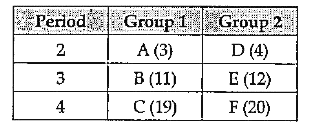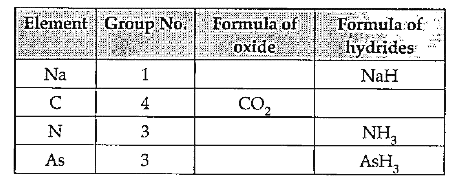Complete Solutions to TOPIC 2 Studying Individual Groups (5 Marks Questions) of chapter THE PERIODIC TABLE of Class 9 book with complete answers and questions
| Class 9 | CHEMISTRY |
| Chapter | THE PERIODIC TABLE |
| OSWAL | TOPIC 2 Studying Individual Groups (5 Marks Questions) |
| Number Of Questions | 34 |
| Academic Year | 2023-24 |
Name the alkali metals. How many electrons(s) do they have in their outermost orbit.
View SolutionTake any one alkali metal and write its reaction with Oxygen
View SolutionTake any one alkali metal and write its reaction with Water
View SolutionTake any one alkali metal and write its reaction with Acid
View SolutionName or state the following with reference to the elements of the first three periods of the periodic table.
Noble gas with duplet arrangement of electrons.
View SolutionName or state the following with reference to the element of the first three periods of the periodic table.
Metalloid in Period 3.
View SolutionName or state the following with reference to the elements of the first three periods of the periodic table.
Valency of elements in Group 14 and 15.
View SolutionName or state the following with reference to the elements of the first three periods of the periodic table.
Noble gas having electronic configuration : 2, 8, 8.
View SolutionName or state the following with reference to the element of the first three periods of the periodic table.
Group whose elements have zero valency.
View SolutionName or state the following with reference to the elements of the first three periods of the periodic table.
A covalent compound formed by an element in Perid 2 and a halogen.
View SolutionName or state the following with reference to the element of the first three periods of the periodic table.
Non-metallic element present in Period 3 of Groups 15 and 16.
View SolutionName or state the following with reference to the elements of the first three periods of the periodic table.
An electrovalent compound formed by an alkalin earth metal and a halogen.
View SolutionName or state the following with reference to the elements of the first three periods of the periodic table.
Bridge elements of Period 3 of Group 1, 2 and 3.
View SolutionName or state the following with reference to the elements of the first three periods of the periodic table.
Alkali metal in Period 3 that dissolves in water giving a strong alkali.
View Solution(a)Name the first three alkaline earth metals.
(b) Write their reactions with dil hydrochloric acid.
View SolutionThe table given below shows the position of element U, V, X, Y and Z

Identify metals, non-metals and noble gases
View SolutionThe table given below shows the position of element U, V, X, Y and Z

Identify most reactive metal and non-metal
View SolutionIn the table given below, six elements are shown with their atomic numbers given in parenthesis.

What is electronic configuration of element C.
View SolutionIn the table given below, six elements are shown with their atomic numbers given in parenthesis.

Number of shells in atom E.
View SolutionIn the table given below, six elements are shown with their atomic numbers given in parenthesis.

Number of valence electrons in atom A.
View SolutionIn the table given below, six elements are shown with their atomic numbers given in parenthesis.

State whether element B is non-metal or metal.
View SolutionIn the table given below, six elements are shown with their atomic numbers given in parenthesis.

Among elements A, B, C, which one has largest atomic size.
View SolutionComplete the following table :

View SolutionAn element with atomic number 5 belongs to III A group of the modern periodic table . Find Oxide of element .
View SolutionAn element with atomic number 5 belongs to III A group of the modern periodic table. Find the number of valence electrons
View SolutionAn element with atomic number 5 belongs to III A group of the modern periodic table. Find Valency
View SolutionAn element with atomic number 5 belongs to III A group of the modern periodic table. Find Metal or non-metal or metalloid
View SolutionAn element with atomic number 5 belongs to III A group of the modern periodic table. Find Name of the element
View SolutionAn element with atomic number 5 belongs to III A group of the modern periodic table. Find Hydride of element
View SolutionFrom the standpoint of atomic structure, what determines which element will be the first and which the last in a period of the periodic table?
View SolutionHow does valency and valence electrons vary on moving from left to right in II period
View SolutionName the following:
An alkaline earth metal in period 3 of the periodic table.
View SolutionThe elements of the third period of the Periodic Table are given below:

(a) Which atom is bigger, Na or Mg? Why?
(b) Identify the most (i) metallic and (ii) non-metallic element in Period 3.
(c ) Which is more non-metallic, S or Cl?
(d) Which has higher atomic mass, Al or Cl?
View SolutionMetalloid in 3rd period.
View Solution
TOPIC 2 Studying Individual Groups (5 Marks Questions) questions and complete solutions for chapter THE PERIODIC TABLE of ICSE of Class 9
All Exercises from OSWAL Class 9 CHEMISTRY THE PERIODIC TABLE
- EXERCISE 5(B)
- EXERCISE 5(C)
- TOPIC 1 Modern Periodic Table and its Periodicity (1 Mark Questions )
- TOPIC 1 Modern Periodic Table and its Periodicity (2 Marks Questions )
- TOPIC 1 Modern Periodic Table and its Periodicity (3 Marks Questions )
- TOPIC 1 Modern Periodic Table and its Periodicity (5 Marks Questions )
- TOPIC 2 Studying Individual Groups (1 Mark Questions)
- TOPIC 2 Studying Individual Groups (2 Marks Questions)
- TOPIC 2 Studying Individual Groups (3 Marks Questions)
- TOPIC 2 Studying Individual Groups (5 Marks Questions)